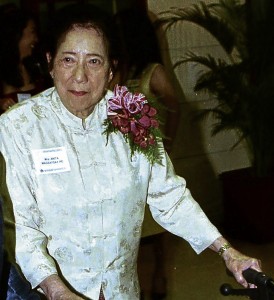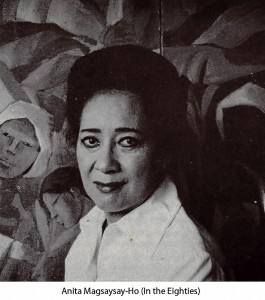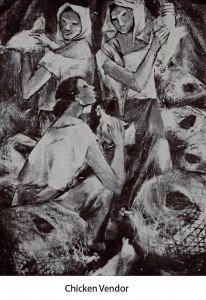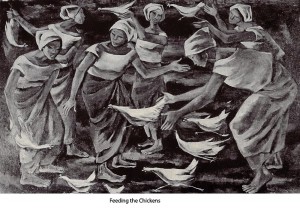
The female Amorsolo” was a phrase-paean ascribed to the recently departed Anita Magsaysay-Ho, by virtue of the fact she was the only female member of the so-called Thirteen Moderns, a list drawn up by Victorio Edades, pioneer proselytizer of modern art in the country.
The names referred to the artists who, in his estimation, upheld the aesthetic values of an expressive formalism dependent primarily on the sheer manipulation of space, line, color and form.
Ho accepted the tribute graciously but, in fact, endured it, for in a long-ago interview this writer had with the artist, she declared: “I don’t want to paint like Amorsolo now. Not that I don’t like his works. It’s just that there will always be only one Amorsolo.”
While initially socially formal, Ho, when plied with successive questions, warmed up to the conversation, generously sharing much information on her personal background and art techniques.
Excerpts
You were one of the first Filipino painters to have studied at the famous Cranbrook Academy of Art and Design in Michigan in the United States. Could you tell us something about this school? How did you get there, in the first place?
On the recommendation of a friend. I sent samples of my work to Cranbrook and I was accepted. Cranbrook is an exclusive school endowed by the Booth family of the Detroit News. The place is beautiful, complete with rolling hills and lakes and you could paint until late at night. Most of the teachers came from Europe— people like Carl Milles, [Eero] Saarinen, and [Laszlo] Moholy-Nagy. There were only about a hundred students. There were students of architecture, weaving, ceramics, sculpture and painting. I think there were about 20 painters. I was very eager to learn about the medium of egg tempera under Zoltan Sepeshy. I think he was also Joya’s teacher when Joya went there.
 When did you start doing paintings of peasants feeding chicken and mending fishnets?
When did you start doing paintings of peasants feeding chicken and mending fishnets?
I was looking for a subject I could feel for, something I could really paint. Well, I am a woman and I know how a woman feels, but what really inspired me to do those women is Bruegel. There was a Bruegel painting of some women in the fields at the Cranbrook museum.
Do you base your paintings on photographs? Do you go out to the provinces and take photographs of women feeding the chicken and women carrying things on their heads?
Oh, no, I hate that. You will always be limited by a photograph. What I want is to create my gestures freely. Maybe some of those poses in my paintings are not humanly possible—the way their bodies are angled in a certain way—but in the context of the whole composition, I think they’re absolutely right.
And those eyes. Your faces have nothing on them but black dots. Is there any specific reason why you do them that way?
I wanted to make them look different. So I exaggerated their eyes and came out with these black dots. After a while those dotted eyes began to bother me, so from then on, I painted the eyes always looking down.
You say you never use photographs as a basis. You do sketches then, I suppose, before doing a painting.
No, I don’t. You lose the spontaneity that way. Unless, of course, you’re doing a mural or an egg-tempera painting where you cannot afford to make mistake. I sketch directly on the canvas with charcoal. I have an idea of how painting will look when it’s finished. Even the colors. I never depend on tsamba [luck]!

Egg tempera
You mention the medium of egg tempera. Not too many painters here have explored this medium. In fact your name alone has been associated with this medium.
Oh, it’s such a tedious process. At Cranbrook, I had to prepare about 20 boards and it took me about two weeks to prepare them. And the preparation of the pigment you had to do by yourself. It’s such a beautiful medium, but you have to have the patience for it. It’s very, very luminous because of the egg yolk and you get this quality you find only in old Italian paintings. But I can’t do it now. I’ve ended up using acrylic instead. It dries faster. Unconsciously I am always looking for this quality which only egg tempera can give.
How did you get started in painting?

I started painting at the age of 9 under Ireneo Miranda. He was my private tutor. I remember I used to copy the black-and-white illustrations in the Saturday Evening Post.
Why were you drawn to painting and not, say, to music or dance?
During our time, all the children, my sisters and I had to learn some kind of artistic activity. I think playing the piano was the most popular choice. I was just naturally drawn to painting. I was copying illustrations from stories in magazines. It was more like doodling, really.
And your parents, what did they think of your choice?
My parents really encouraged me. When I was already painting in oil, I was never allowed to do any housework. I was not expected to do anything except to paint. They would just call me in for meals. Unlike my sisters, I never really learned to play the piano well. My father always used to say, “When Anita starts to play piano, it is time to leave the room!” But I still love music. I paint with music playing in the background… I had forgotten to tell you: I owe a lot to a German painter by the name of Adolf Heineman. He was married to a Filipina, you see. He was teaching art and I was one of his many students. When the war broke out he stayed on. I used to bring food to his house in Pasay. The poor man died during the war. I learned a lot from him especially about light and shadow, and also the proper use of colors.
But you eventually did go through formal art studies, didn’t you?
Yes, I studied at the University of the Philippines under Fabian de la Rosa, the two Amorsolos, Fernando and Pablo, and then again under Ireneo Miranda and Vicente [Rivera y] Mir. I think, of all my teachers, Pablo Amorsolo was the one who conveyed the most to his students. As a painter, he may not be as good as Fernando Amorsolo, but as a teacher, he really taught us all the basic things we needed to know about art.
Influences

Who were the major influences in your development as an artist?
Well, it’s hard to say. You see, you’re influenced not only by your teachers but also by your fellow students. But during our time, I would think Fernando Amorsolo was the most influential. We all used to paint like him.
What happened after your studies at UP?
I went to the States. I studied at the Art Students’ League [in New York] under Kenneth Hayes Miller, an excellent teacher. He was a very old man and he had a “creed” on how to paint!
You mean like a 10 Commandments of painting?
Yes! He used to say, “You should paint like this, and not like that.” I don’t know if it was the best technique, but I still follow it… Oh, I forgot to mention: When the war broke out, I was studying at the College of Design on Isaac Peral [Street]. It was headed by Edades. He was teaching us modern art. We were imitating the Bauhaus, which was one of the forerunners of modern art. I also studied under Mr. Ruiz—I can’t remember his first name—[Enrique], and also under Angel and Juan Nakpil, both very progressive architects. Very few people knew of this school. Anyway, after the war, I went to the Art Students’ League and there I was always using a palette knife. In Mr. Edades’ school, we were always told, “You can do what you want, you must do what you feel.” So when Kenneth Hayes Miller saw me, he took my palette knife away and scraped all the paint off my canvas! I felt so bad I really felt like crying! I was taught that an artist should paint the way he wanted to. Well, in Kenneth Hayes Miller’s class, he wanted his students to paint like him. He wanted flesh to look like flesh, you know what I mean? He had very definite rules. For example, have you ever noticed that when you paint one thick layer over another thick layer, you get a kind of “chalky” effect? Mr. Miller believed that you should always have a thin layer in-between those two thick applications. He was a great believer in “veils.” Oil is very transparent and it always shines through.

Perhaps our art schools should all learn from the methods like the Art Students’ League.
I don’t mean this as a reflection of our former teachers at UP, but, you see, in school we were never told the reason why something was wrong. The teacher would come to me and say, “Oh, the mouth is all wrong.” I knew what I had done wrong but I never found out why. A teacher would tell me that my painting was “chalky” but I never knew why. He would not tell you why, he would just correct it. At the Art Students’ League, you learned all the basic things. Painting was related with everything else; you always compared one element with another, such as contrasts between light and dark.
In that school you had to have your own built-in self-discipline. Nobody will discipline you. You could be absent from school and nobody would care. The study was very rigorous. In our sketching class, you had to sketch very fast because, after one minute, the model would shift to another pose, and then another. It was a very good practice in the study of gestures.
Disciplined
Are you still a disciplined kind of painter after all these years?
Yes, I am. After my husband leaves for the office, you will find me painting until dark. I only stop when he comes home from work.
What about abstraction, how do you fell about it?
I can enjoy an abstract painting but I don’t think I can ever paint one. I just don’t feel it. But I sometimes use abstraction to help me with my figures. Like the accidental loop of paint when it’s splattered on a canvas. I work around these accidents. Suddenly they become trees or rocks and then I draw my women around them.

Do you accept commissions? What is your attitude toward doing a commissioned painting?
I think with commissioned works, you end up painting for the person [who commissioned it], not for yourself. You’re always wondering whether he or she will like it. I have promised so many paintings to prints, it isn’t funny anymore. What I do is I try to accumulate around 10 paintings and then I call all my friends in to choose for themselves. I don’t like to paint with the idea that this one is for so-and-so, that one is for so-and-so.
What do you think is your best quality as a painter?
I think it’s persistence. The ability to keep on going, trying and doing things all over again to achieve what one had in mind to achieve. Of course, you must really enjoy painting. You have to really love it and want to know all about it… You know, it’s like looking for a cook, I keep telling my children, “Don’t look for someone who already knows how to cook. Rather, find someone who’s interested in cooking and then you can teach her everything.”













































